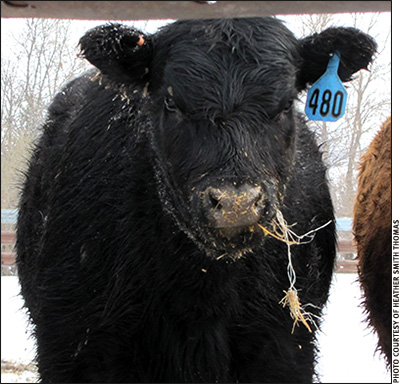Software Disease:
The Hazards of Plastic and Twines
Avoid letting cattle taste-test litter and debris.
Cattle, especially young ones, are curious and like to chew on anything within reach. Smell and taste are major ways they “check out” the world around them, so calves (even yearlings or older animals) tend to sample their environment. They may eat baling twine, plastic bags and other debris that end up in their pens or pastures. The strange material may taste or smell interesting, so the animals chomp it down.

Plastic bags, party balloons, weather balloons and other “fallout” from human activity can end up inside cattle, and there’s no way to remove the blockage without surgery. Without knowing the problem, very few veterinarians are going to perform exploratory surgery on cattle. The result is a quiet, slow, painful death, with no definitive symptoms.
Sometimes cattle accidentally ingest foreign objects in their feed just because they eat hurriedly and don’t bother to chew much the first time around. Every year a few cattle die mysteriously — often after a slow decline with loss of weight and diarrhea — and the owner and veterinarian may be clueless about the cause of death unless the animal is opened up to find the ingested material blocking the gastrointestinal (GI) tract.
To illustrate this point, Colorado Springs veterinarian Gary McIntyre, of Airway Veterinary Hospital, was once called out to a ranch to check a steer that was slowly wasting away with watery diarrhea and getting weaker each day. The steer was a little bloated and wasn’t eating well, but drank a lot of water. His temperature was normal. His heart and lungs seemed fine. He didn’t have hardware disease, and none of the fecal or blood tests that McIntyre performed showed any indication of disease. The steer finally died, and McIntyre did a necropsy only to discover a large wad of denim (most of a pair of pants) plugging the stomach.
All kinds of things have been discovered in the guts of cattle at necropsy. Ingestion of various materials (usually plastic) has become a common killer of cattle today because they have access to more litter. Their pastures or pens may be next to a highway where litter from passing cars blows across the countryside. If cattle (or hayfields) are within a mile of dumpsters, construction sites or a subdivision, garbage may blow over the fields and cattle may find interesting objects to chew on, or the material may get baled up in hay.
Plastic bags, party balloons, weather balloons and other “fallout” from human activity can end up inside cattle, and there’s no way to remove the blockage without surgery. Without knowing the problem, very few veterinarians are going to perform exploratory surgery on cattle. The result is a quiet, slow, painful death, with no definitive symptoms.
Small pieces of material may go right through, and you would never know the animal ate them. If it’s a large blockage, however, the animal may stop passing manure and stop eating. The GI tract is “full” so there’s no room for more feed. A partial blockage leads to diarrhea, because only the liquid contents of the gut can make it through. The diarrhea leads to suspicion of diseases like coccidiosis, salmonella, bovine viral diarrhea, E. coli, Johne’s disease, liver flukes or other parasites, but there is no treatment for “plastic disease.” The best prevention is to pick up every piece of garbage you find in your pastures or hayfields, including old hay twine, and never rebale broken bales without first removing the twine.

Editor’s Note: Heather Smith Thomas is a cattlewoman and freelance writer from Salmon, Idaho.






